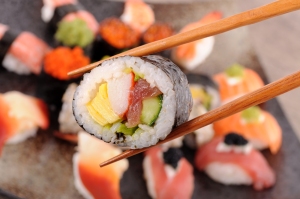Japan, June 25: I know I haven’t blogged for a long time, I successfully came to Ritsumeikan University and became a part of Sakura Student Exchange Program. In this blog post, I want to share my journey from India to Japan and back. My 8 days expedition of Japan was very cinematic.
The Japan-Asia Youth Exchange program in Science also known as SAKURA Exchange Program in Science is a program administered and conducted by Japan Science & Technology Agency (JST). Ritsumeikan University, Japan was the host for the program held from June 13 to June 20 with a theme of Drone Technology. It is a matter of great pride that I got to be a part of the program.
First flight experience is unforgettable for any one. I still remember everything in minute detail, it seems like yesterday I boarded flight in Bangalore. Time flies very fast.
PEOPLE AND CULTURE

From what I’ve seen, Japanese people want to keep the world in at least as good of a state as when they found it. Take, for example, a plant growing next to a sidewalk. In India, someone is going to walk by, see the plant, and decide they want to stomp on it. In Japan, that little plant is going to flourish. This doesn’t just apply to plants, but also to fixtures on the sides of buildings, signs, walls that stay clean and much more.
People tend to avoid being the center of attention. It is rare that someone makes a loud noise, makes a “scene” in a public place. This is sharply contrasted with India where people like to ride public transit while blasting loud music or scream at other passengers.
For the most part you won’t get unsolicited advice while wandering around Japan. Perhaps if you’re looking really confused and standing in the same spot for 10 minutes someone will come help. That said, if you ask for help, language barriers aside, you will receive it.
Kids go everywhere by themselves. Japan is so safe that families have a tradition of getting their children out and about by themselves doing stuff as young as 5 years old. It’s nothing to see young kids 6, 7 years old riding the subways alone to go to school.
THE ATTIRE
There are many awesome things you can do in Japan that you can’t do in other countries and the important one is being dressed in a Kimono or a Yukata. Kimono and Yukata are traditional Japanese garments that have charmed people around the world with their beauty, style, and traditional aesthetic. We were lucky to get an opportunity to wear the Yukata. It feels like true Japanese when we put on those wonderful apparels.

AUTHENTIC JAPANESE CUISINE
Japan is one of the best culinary countries in the world! Although it is a small country compared to many other countries in the world, but every region and island has its own specialty when it comes to food. Most restaurants in Japan are specialty restaurants, specializing in one dish or one type of cuisine.
Some Japanese Food Dishes You Must Try
1. RAMEN
You will find Ramen basically all over Japan, on almost every street corner. It is a wheat noodle soup dish that was originally imported from China. Ramen are eaten with chopsticks, and as the noodles get soggy pretty quickly you should eat them immediately after they are served.

2. SUSHI
Sushi is raw fish and seafood packed together with rice and vegetables into beautiful pieces. Each little piece is almost like an art!
Although I did not like the taste, it is worth the try in the land of Sushi.

3. TEMPURA
Japan can thank the Portuguese for Tempura, as it was Jesuit missionaries in Nagaski who first introduced Japan to the art of batter frying. Tempura is chunks of seafood and vegetables dipped in a light batter and cooked in canola and sesame oil. It is normally eaten together with a bowl of rice.
Japan really surprised us with its cuisine; it is very tasty and healthy with a great variety. They really put their pride into their cooking and their food, and it is all very clean as hygiene is very important in Japan. Japan has food for everybody, whether you like seafood, raw food, strange meat, vegetables or noodles….they have it all!

BUILDINGS
1. TEMPLES / SHRINES

Whenever you go to a Temple you’re expected to leave your shoes outside. Some temples provide you with bags you can carry your shoes in, some have lockers, and others just have a large shoe orgy on the front entrance. Orange paint was believed to keep evil spirits away, which is why many of the temples and gates are painted in bright orange. Admission is usually free, with areas where you can donate.
2. MEGA MALLS

There are many massive “Malls” throughout Japan, following the same pattern of being about eight floors tall. One of the floors will be dedicated to mobile phones, another to model building, photography, video gaming, comics, household appliances, and food. Most of the malls are twice or even thrice the size of Indian Malls.
3. AUTOMATED TOILETS

An electronic Japanese toilet has a bidet built in, a device which cleans your ass by spraying water into it. The toilet has a complex control panel, with bidet options for weak, strong, and a special woman-only option. The toilet is also heated, and can play noises. You might have a tough time learning the functions of all the buttons like we did. But trust me you will enjoy this once you figure out the working of it.
TRANSPORTATION
Just as the world loves its cars like Toyota and Mitsubishi, there are some great driving habits of Japanese people that are worth learning too.
Considering the fact that every country has different traffic and driving rules, one cannot apply the rules of one country in another. However, there are certain habits that make for the best habits ever, irrespective of whether they are a part of the rules.
No one honks in Japan. Honking is considered rude in Japan. It’s even considered as aggressive. Instead, drivers are very courteous. They let other drivers in front of them.
Almost no one moves in Japan unless a green light tells them to.
TRAINS

The trains here are amazing. Unlike India, they don’t make horrible high pitched screams, they aren’t covered in hobo urine, they are on time, and if they are not the management makes sure that an alternate train is arranged to avoid wasting time of the passengers. The trains even have racks above the seating areas where one can leave their bags. In India, your bags would disappear if left on one of these racks. Unlike India people form lines to enter and exit the trains and not rush at the entrance.
SHINKANSEN (新幹線)

The Shinkansen is a Bullet Train which we took from the Maibara Train Station to Kyoto. Maibara train station is the place to stand and photograph as they pass in the blink of an eye. This may not sound exciting, but trust me, it is quite an experience. This train travels very fast and it took 19-minute for us to reach Kyoto Station. It clocked speeds up to 275 kmph. Purchasing tickets for the Shinkansen is very similar to purchasing tickets for an airplane, minus all the painful security checks. They do cost a surprising amount though, not affordable for a daily trip. That said, they are effectively the same as taking an airplane.

THE SOUVENIRS
When it comes to Japanese souvenirs the list is endless, really! From everything Pokémon and Hello Kitty to electronics and unique beauty products, Japan has something for everyone.
1. KIT KAT

Kit Kats sold in Japan come in several unique flavours – setting them apart from the Kit Kats of other countries. In fact, most of these flavours are only available in Japan.
2. FOLDING FANS

Folding fans or “sensu” are usually made of bamboo or Japanese cyprus then connected by washi paper. They come in a lot of designs and are worth gifting.
3. JAPANESE MANGA AND ANIME
Walking into a Japanese bookstore, you might understandably be mistaken to think that all books are Japanese comics. Their covers are full of adorable illustrations. But alas, manga are their very own specific section and these sections are as big as a book stores in India. We bought “Death Note”, “Naruto” , “Dragon Ball-Z” and much more.

I am in love with Japan. Everything about it seems awesome. The place and the people are so wonderful that anyone who visits and discovers the place would crave to stay longer and some might even want to stay forever just like what we felt.
This was first published in writer's blog https://rahulrpai.wordpress.com. Rahul Pai is pursuing Mechanical Engineering at NMAMIT, Nitte and visited Japan recently as part of Sakura Student Exchange Program .
Let the Truth be known. If you read VB and like VB, please be a VB Supporter and Help us deliver the Truth to one and all.
New Delhi (PTI): A Private Member's Bill seeking a clear legal framework for regulation of deepfakes has been introduced in the Lok Sabha.
The Regulation of Deepfake Bill, introduced by Shiv Sena leader Shrikant Shinde in the House on Friday, aims to protect citizens by mandating prior consent from individuals depicted in deepfake content.
"Misuse of deepfakes for harassment, deception and misinformation has escalated, creating an urgent need for regulatory safeguards," Shinde said.
The Bill also lists penalties for offenders creating or disseminating deepfake content with malicious intent.
"With advancements in artificial intelligence and deep learning, deepfake technology has emerged as a significant tool for media manipulation. While the technology has potential applications in education, entertainment and creative fields, it also poses severe risks when misused, threatening individual privacy, national security and public trust," Shinde said in the statement of objects and reasons in the Bill.
The proposed Bill seeks to establish a clear legal framework to govern the creation, distribution and application of deepfakes in India, said Shinde, a three-term Lok Sabha member from Kalyan.
The Bill also seeks to establish the Deepfake Task Force, a dedicated body to combat national security implications and evaluate the influence of deepfakes on privacy, civic participation, and potential election interference.
The task force will collaborate with academic and private sector institutions to develop technologies that detect manipulated content, thereby promoting credibility in digital media.
The Bill also proposes to establish a fund to support public and private sector initiatives in the detection and deterrence of advanced image manipulation.
A Private Member's Bill is a procedure of Parliament that enables lawmakers, who are not ministers, to draw attention to issues that might not be represented in Government Bills or to highlight the issues and gaps in the existing legal framework that require legislative intervention.





